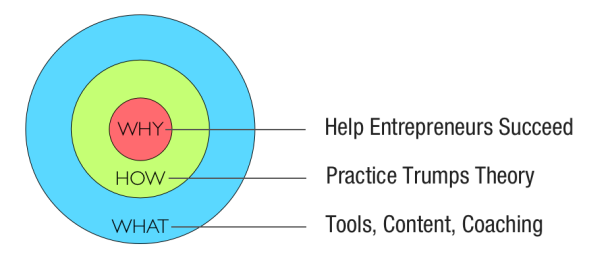In his book, The Lean Startup, Eric Ries describes the constant challenge entrepreneurs face between “Pivoting and Persevering”, but he doesn’t describe the even harder challenge of deciding when to hit the reset button. (Maybe Eric views “reset” as a “hard pivot”?)
With my last company, WiredReach, while I eventually succeeded in discovering viable “customer problems” to solve and even got pretty far in terms of validating the business model (with positive cash flow), something was grossly missing: a passion for customers and their problems. I had unknowingly tweaked my founding vision along the way and had become a company with a “solution looking for a problem.” The viable customers and markets I found were unexpected.
People form a startup for several reasons, many of which can lead to successful businesses (and/or exits). However, I had reached a stage where I was looking for something more: purpose. I was forced to confront my problem–passion disconnect and saw two options. I could hire in the missing passion, or I could sell the company. Legacy can be an advantage or a constraining disadvantage, and this wasn’t an easy decision to make.
In the past two years, I stumbled into new sets of problems, ones that struck a chord on many levels. I had set up my personal blog as a way to hold myself publicly accountable, but along the way, I got swept into the world of Lean Startups and joined in on the conversation. I was positively surprised by the reaction and encouragement I received. I reluctantly started writing a book and, even more uncomfortably, started running workshops which led to the development of two products — Lean Canvas and USERcycle.
When I saw enough dots connecting, I decided to hit the reset button. I called up my first customer (who also helped bootstrap WiredReach), and within two weeks, we had a deal for sale. After a short period of company transitioning, I started laying the groundwork for a new company: Spark59.
Spark59 — A new beginning
Over the holidays, I was brainstorming a simple one-line directive for the company. This isn’t a new concept. Guy Kawasaki describes it as “creating mantra over a mission statement.” The Heath brothers share some examples in their book: “Made to Stick.” And one I particularly like is Simon Sinek’s TED talk on the Golden Circle.
The power of this directive is that it guides (true north) decisions and can scale across the company:
Herb Kelleher, CEO of Southwest Airlines, once told someone, “I can teach you the secret to running this airline in thirty seconds. This is it: We are THE low-fare airline. Once you understand that fact, you can make any decision about this company’s future as well as I can”.
Source: Made to Stick by Chip and Dan Heath
Here is the Golden Circle I drew:

The WHY: Help Entrepreneurs Succeed
This is the simple, one-line directive that helps us make “true north” decisions.
Some examples of things that fall out of this:
1. Entrepreneurs, not investors or accelerators, are our customers.
2. Success = Positive outcome for the entrepreneur + Positive impact for the “world”
3. Sometimes, success = killing a project
I discovered this core after finding myself boarding a 9-seater plane in below 20-degree weather to deliver a workshop in Canada (twice) and asking myself WHY. This is also why I implemented a “pay with a tweet” button for my book with variable discounts by geography down to free after discovering interest from parts of the world that would normally never buy a book at full price.
The HOW: Practice Trumps Theory
This is why we are different and worth paying attention — a.k.a, your unique value proposition.
Some examples of things that fall out of this:
1. Unlike accelerators, investors, and consultants, who might share the same core, we are also practicing entrepreneurs.
2. Our differentiation comes from synthesizing the best ideas (not just limited to Lean Startup) through rigorous testing into actionable practices.
3. We are honest about sharing what we know (and what we don’t know) and always seeking to learn.
When I would share early details on the products I was developing with others, I often got responses like this:
“Why are you building products for startups? Yes, there’s lots of them but most of them will fail and they don’t have any money anyway.”
I think that’s backward. In the past two years, I’ve found myself interested in exploring the “most products fail” problem, and I’m particularly drawn to creating “learning versus optimization” products — ones that help more entrepreneurs move into the “right half” by reducing uncertainty in their products. Because we first test and refine ideas on our products, we not only know they work, but we’re willing to bank our success on the success of our customers.
The WHAT: Tools, Content, Coaching
These are the products (solutions) we build.
Some examples of things that fall out of this:
1. From the outside in, we build web-based tools, create content, and teach workshops.
2. Each of these products is interconnected and helps us maximize learning, i.e., better understanding the problem (and customers).
3. It is from this understanding that we experiment with possible solutions.
A key takeaway from this is that we are NOT a “product-focused” company but a “problem-focused” one. Each product is an experiment, and if it fails to deliver on the core, we have no problems killing it. That is also why the company name doesn’t have a product or lean reference in it but rather a problem reference.
Startups can consume years of your life, so make sure you pick a problem worth solving.
What does your Golden Circle look like?
P.S.
In the future, I’ll be posting more regular shorter pieces on the Spark59 company blog where you’ll also get to hear from other team members. I’ll leave my longer-form posts for my personal blog.
Thanks for reading…
